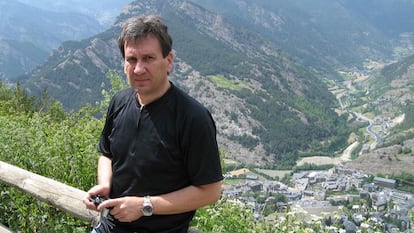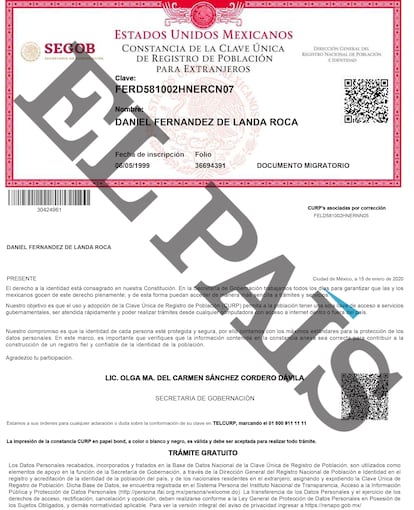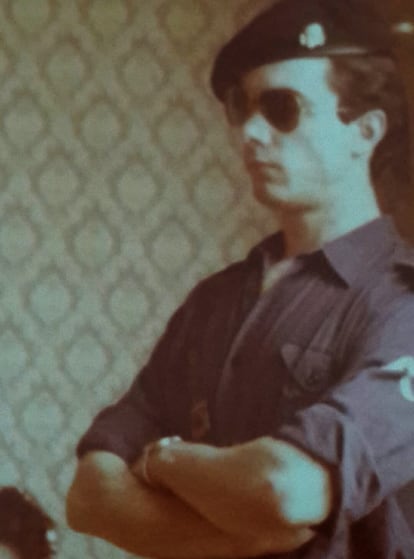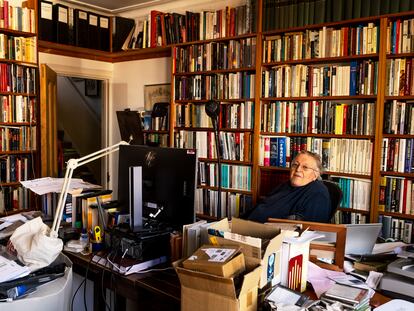The secret lives in Mexico of two neo-fascist fugitives from Spain
EL PAÍS located Daniel Fernández de Landa and Íñigo de Guinea, involved in the deaths of a community leader and a soldier in 1980, during the Spanish transition to democracy. For around 40 years they have enjoyed complete impunity

An EL PAÍS investigation has revealed that Daniel Fernández de Landa Roca and Íñigo de Guinea Pérez, accused of some of the bloodiest crimes of Spain’s transition to democracy, have been hiding out for more than 30 years in Mexico
Fernández de Landa is accused of murdering Madrid community leader Arturo Pajuelo Rubio after a May Day demonstration in 1980. Five days later, the fascist militant joined a mob that attacked the San Bao bar in Madrid, killing 20-year-old soldier Juan Carlos García Pérez. Now 64 years old, Fernández de Landa has been hiding in the Mexico City area since 1985.
Íñigo de Guinea also fled to Mexico after being accused of the near-fatal stabbing of Joaquín Martínez Mecha, the man who was with Pajuelo when the latter was killed. Now 60 years old, de Guinea lives with his family in León, a city of 1.5 million people in the state of Guanajuato.
The two fugitives staged Hollywood-style escapes in 1980 to evade the Spanish justice system which prohibits in-absentia trials for serious crimes. For more than three decades they have enjoyed peaceful, anonymous lives 5,500 miles (9000 kilometers) from Madrid while remaining on Interpol’s list of wanted fugitives.
Once in Mexico, the two neo-fascists rented apartments in their own names, started businesses, and duly registered as foreign residents with the appropriate Mexican government agencies. Fernández de Landa went a step further and obtained Mexican nationality in 1990. Íñigo de Guinea eventually changed his first name to Ignacio, according to documents obtained by EL PAÍS.

Our first conversation with de Guinea happened late one afternoon in May. It lasted barely three minutes.
“Íñigo de Guinea?”
“Yes, that’s me.”
“I am a Spanish journalist. We are writing a story about certain events that happened in Spain. We want to talk to you.”
“Sure, no problem. But I’m in the car right now. Can you call me later, in a couple of hours?”
“We would like to hear from you about some events that took place in the 1980s. You were involved – I’m sure you remember.”
“Yes, yes, of course…”
He asks us to call back in two hours, but then doesn’t answer the phone. We keep trying and the next day, he finally picks up the phone.
“You were charged in Spain with the murder of Arturo Pajuelo and participating in the attack on the San Bao bar…”
“I was involved, but not how they say – not everything they say is true. I wasn’t at the trial so I couldn’t defend myself.”
“You weren’t at the trial because you fled the country and have been a wanted man for three decades.”
“I left because I got a job. I was 18 years old and afraid. Lots of people ended up in jail without having anything to do with it. What if I couldn’t prove my innocence?”
“Joaquín Martínez, who survived the attack against Pajuelo, identified you as the killer.”
“They framed me – I wasn’t there. I never hurt anyone. As for the San Bao bar incident, I was nearby but didn’t go inside.”
“Why did you change your name to Ignacio?”
“I was told that there is no Mexican saint named Íñigo.”
He says goodbye, speaking in a slow tone. He claims to have lost contact with Fernández de Landa but admits to working with him 20 years ago at a Mexican plastics company. This shared work experience at the plastics company is the trail that this newspaper followed to expose the secret lives of de Guinea and Fernández de Landa in Mexico.
To find Fernández de Landa, it was first necessary to travel to Naucalpan de Juárez, a municipality located just northwest of Mexico City. In 1990, Fernández de Landa was 32 years old. He ran a small import and distribution company with 11 employees called Distribuidora e Importadora Los Delfines. The Spaniard started the company with a now-deceased Mexican restaurateur. The company shut down after nine years, and a workshop now occupies the ramshackle building. The sound of heavy machinery roars from behind the metal gate.

The next relevant location in this story is San Juan de Aragón, a chaotic swarm of squat homes in the municipality of Gustavo A. Madero, where finding Fernández de Landa’s address turns into an odyssey. Sometime in the 1990s, the fugitive came to this densely populated area after marrying the daughter of a Mexican industrialist who owned a yarn factory and a banquet facility called Salones Cristal.
To his new family, Fernández de Landa appeared to be a discreet and polite man – an upstanding person who transformed his father-in-law’s textile business into a plastics factory called Plásticos Landa. According to the commercial register, the company manufactured the Plastmade brand of household utensils and containers. The business became successful and employed a dozen workers. It provided the neo-fascist and his Mexican wife with a comfortable living and a few luxuries like the flashy cars they drove.
Fading memories of Fernández de Landa are all that remain today in their old neighborhood of San Juan de Aragón. The house where the couple lived with their daughter has been demolished to make room for the parking lot of the imposing, white-walled Church of Jesus Christ of Latter-Day Saints. “They sold the land where they had their factory and home to the church. We’re still holding out,” said Mari Paz, the couple’s neighbor for 20 years. “He never said anything about his past life in Spain,” said the elderly woman from her window, who remembers him as having polite manners.
Fernández de Landa stayed in the plastics industry, and managed companies like Hidro Raf, which made plastic bottles and containers. The man accused of killing two people during Spain’s transition to democracy often traveled to international conferences, and his company participated in the 2012 Antad retail trade show in the Mexican city of Guadalajara.
An advantageous change in nationality
Fernández de Landa was able to maintain a low profile after obtaining Mexican citizenship in 1990 while Interpol was still on his trail. The nationalization process in Mexico requires presentation of the applicant’s police record from the country of origin. So how did the fugitive get around this requirement? “In Mexico, anything is possible with money. More so back in those days,” says a former Mexican prosecutor. In 1995, more than 100 members of the ETA Basque terrorist organization in Spain were identified as having fled to Mexico to evade Spanish justice.

Fernández de Landa didn’t drop off the radar of Spanish justice when he fled the country. The Audiencia Nacional, a centralized high court with jurisdiction over some major crimes, maintained an outstanding warrant for murder until 2011, and then issued a second arrest warrant for the fugitive that expired in February 2018. But the man accused of killing Pajuelo and García became a master of misdirection.
It’s late morning in the Valle Escondido residential development, a compound of luxury homes surrounded by golf courses and high-tech security systems to protect the powerful Mexican elites that live there. No one knows Fernández de Landa here, even though he lists his Valle Escondido home as his official mailing address .”We never heard of this man,” says a maid at the fugitive’s purported home. A gardener who works at the US$2 million house nods silently. This newspaper was unable to contact Fernández de Landa to get his side of the story.
Refuge in Guanajuato
A five-hour drive northwest from Mexico City lies Guanajuato, one of the most violent states in the country (2,516 homicides in 2021). There, Íñigo de Guinea Pérez chose the city of León to put down roots, raise a family and escape the clutches of Spanish detectives who were after him for stabbing Pajuelo’s friend, Joaquín Martínez.
According to the León property registry, Íñigo de Guinea lives in a single-family home with a garden on Canciller Street in the Real Providencia residential development. He is registered as Ignacio instead of Íñigo. His home doesn’t stand out among the jumble of semi-detached houses where a local neighborhood watch was created to deter intruders and the frequent armed robberies and burglaries. “Neighborhood Watch,” reads a sign next to a police station. “Looking for something?,” asks an older man on a bicycle who is keeping an eye out for strangers in the area.
The residents of Real Providencia are unaware that for 30 years, two Spanish courts have been pursuing their neighbor for intentional homicide. The two arrest warrants for de Guinea, who now speaks with a strong Mexican accent, remained active until 2006 and 2011, respectively.
According to the León commercial registry, de Guinea started a plastic products company in 2000 when he was still wanted by Interpol. His business operated out of a large industrial building 12 miles (20 kilometers) from his home. These days he rents an apartment in Dorado Residencial, a quiet community in León next to the Vía Alta shopping center, and sells products online.
The man doesn’t try to hide his obsession with weapons. He likes to frequent shooting clubs, and his social media activity (posted under a slightly different surname) reveals that his fascist convictions have not waned over time. He is still in contact with former members of Spain’s Falange Española de las JONS, a fascist political party that emerged in 1976, and former members of the Spanish Youth Front (Frente de la Juventud), a violent group of militants who committed murders, assaults, and kidnappings.
The day of the tragedy
The story of how these two fugitives ended up in Mexico begins in the period of modern Spanish history that saw the end of the Francoist dictatorship and the consolidation of a parliamentary system, in the form of monarchy under Juan Carlos I. The year was 1980, and Arturo Pajuelo, the second of eight siblings, was 33 years old. He worked as a draftsman in an aeronautical company in Getafe, a community on the outskirts of Madrid. He was passionate about sports, hiking, bullfighting, and his neighborhood association – Guetaria de Orcasitas in Madrid. His neighborhood was haphazardly built up in the 1950s by the construction and telephone company workers that settled there. Pajuelo was an emerging leader in an area full of Andalusian immigrants that fled the poverty of southern Spain, and was pushing hard to get a block of cracked apartment buildings repaired.
It was almost 2pm on May 1, 1980. Pajuelo and his friend, Joaquín Martínez, had left the Labor Day march organized by Spain’s two major labor unions. They were walking down Tarragona Street when they were silently assaulted by two individuals, allegedly the fascist militants Fernández de Landa and de Guinea. The former stabbed Pajuelo nine times in the liver and lungs. Martínez said de Guinea stabbed him twice. A cab driver picked up Pajuelo and took him to the Doce de Octubre Hospital. Martínez was helped by some students from a university music association, as he later recalled.

Pajuelo died despite two surgeries and a transfusion of over five gallons (20 liters) of blood donated by his neighbors. Martinez survived. “I was stabbed twice in the back, with wounds to the kidney and the coccyx. I was in intensive care for 21 days. I think they followed us from the demonstration and just chose us at random,” recalls Martinez, now 67 years old. From his hospital bed, Martínez helped the police develop composite sketches of the attackers – Daniel and Íñigo.
Not trusting in the police, Martinez identified the assailants from the photo archives of the now-defunct newspaper Diario 16. “The one who stabbed Pajuelo was a lightly bearded guy with feminine features – Daniel. I’m 98% sure of it. And, if they put him in front of me right now, I would confirm it 100%″, said Martínez, who had received facial recognition training when he worked in the customs department. He still has a disability from his stab wounds.
Pajuelo’s murder shocked Madrid. More than 20,000 people attended his funeral at Carabanchel Cemetery, and another 40,000 took the streets and participated in a strike, according to press reports at the time.
A fascist mob attacks a bar
Five days after Pajuelo’s murder, a mob of 20 fascists broke into the San Bao bar on Madrid’s Arturo Soria Street brandishing chains, knives, and guns. “Nobody moves or we’ll kill you! Long live Christ!” they shouted. It was their response to a march that day commemorating Pajuelo, in which the demonstrators demanded the outlawing of Fuerza Nueva, the Spanish far-right political party founded by firebrand Blas Piñar. A 20-year-old patron of the bar, Juan Carlos García Pérez, died in the brawl after being shot twice in the back. Three other young men were wounded.
Three years later, a dozen fascist militants went on trial for the San Bao assault, including de Guinea and Fernández de Landa, accused of fatally shooting García. De Guinea’s criminal record already included the alleged stabbing of Martínez, and a previous arrest for participating in the shooting death of José Prudencio García, a 44-year-old man from Madrid.
Fernández de Landa fled the country in 1980 after asking the police officers who were about to arrest him at work if he could take off his waiter’s jacket in the changing room. The militant had been expelled from the fascist Falange Party a year earlier for his “revolutionary and aggressive” behavior, according to court documents from the Pajuelo case.
Not long after Fernández de Landa’s escape, his brother Jesús was arrested carrying two weapons in the town of El Escorial (northwest of Madrid) after being mistaken for a member of GRAPO (a Spanish clandestine Marxist–Leninist group). The two weapons he was carrying were allegedly used in the San Bao attack.
In 1985, the Supreme Court sentenced Jesús Fernández de Landa and Juan Domingo Martínez Lorenzo (aka Perón) to 32 years in prison for murder and attempted murder in the San Bao case, tripling the sentences imposed by a lower court. However, the two were not implicated in the murder of Juan Carlos García, attributed to the fugitive Daniel Fernández de Landa.
Daniel’s whereabouts have remained a mystery for 40 years. Interpol initially thought he escaped to France and was given refuge in a castle belonging to Stefano Delle Chiaie, the Italian head of Avanguardia Nazionale, a neo-fascist organization. Then he purportedly went into hiding in Switzerland.
Felipe Pajuelo, the murder victim’s brother, claims that Arturo didn’t belong to any party or labor union. “The culprits fled, and we were left without Arturo and no justice,” he says. “Forty years later, no one has paid for his murder.”
In Madrid’s Orcasitas neighborhood, a sculpture of a dove commemorates the young, bushy-headed man who fought for decent housing for the poor. A senior citizens’ center bears his name. “Arturo Pajuelo was a born leader – a young man who did a lot for us,” said a local resident.
investigacion@elpais.es
Tu suscripción se está usando en otro dispositivo
¿Quieres añadir otro usuario a tu suscripción?
Si continúas leyendo en este dispositivo, no se podrá leer en el otro.
FlechaTu suscripción se está usando en otro dispositivo y solo puedes acceder a EL PAÍS desde un dispositivo a la vez.
Si quieres compartir tu cuenta, cambia tu suscripción a la modalidad Premium, así podrás añadir otro usuario. Cada uno accederá con su propia cuenta de email, lo que os permitirá personalizar vuestra experiencia en EL PAÍS.
¿Tienes una suscripción de empresa? Accede aquí para contratar más cuentas.
En el caso de no saber quién está usando tu cuenta, te recomendamos cambiar tu contraseña aquí.
Si decides continuar compartiendo tu cuenta, este mensaje se mostrará en tu dispositivo y en el de la otra persona que está usando tu cuenta de forma indefinida, afectando a tu experiencia de lectura. Puedes consultar aquí los términos y condiciones de la suscripción digital.
More information
Últimas noticias
Most viewed
- Sinaloa Cartel war is taking its toll on Los Chapitos
- Oona Chaplin: ‘I told James Cameron that I was living in a treehouse and starting a permaculture project with a friend’
- Reinhard Genzel, Nobel laureate in physics: ‘One-minute videos will never give you the truth’
- Why the price of coffee has skyrocketed: from Brazilian plantations to specialty coffee houses
- Silver prices are going crazy: This is what’s fueling the rally










































